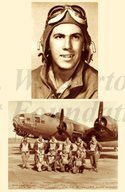
|

|
|
|
|
Robert was born in Ludlow, Colorado, a small mining town in the southern part of the state, to Ralph Morris and Myrtle Slane. His father worked for the Colorado and Southern Railroad as a car checker. Robert graduated from high school in Trinidad, Colorado, in 1941. He entered flight training at a local junior college, and then enlisted in the U.S. Army Air Corps on August 8, 1941 and was sent to Fort Logan near Denver. He went through aviation school as a corporal but graduated as a flight officer. Robert was sent to England as a B-17 pilot, serving with the Ninety-first Bombardment Group, based at Bassingbourne air base near Cambridge. On his third mission he crash- landed in England. On his next mission, this one to Schweinfurt, German Messerschmitts attacked his formation. Robert heard rounds hitting the airplane. His co-pilot froze, leaning forward and locking his shoulder against the wheel. The aircraft began losing altitude. "I stood in the aisle and hit him as hard as I could and finally got him to straighten up," Robert says. With two engines gone and fuel "pouring out," he was flying far below the other formations when enemy aircraft attacked his bomber from the side and rear. With a third engine flaming, he ordered the crew to bail out. Robert crash-landed the plane and was captured by civilians near a small town, Viviers. (All crewmembers except one returned to the United States after the war.) He eventually was incarcerated in Stalag Luft Three where the "great escape" occurred. Most of the eighty prisoners who escaped were captured and returned. The Germans shot fifty of them. Robert says the other prisoners heard about the execution "about two or three days after it happened." He remained in Stalag Luft Three from late October of 1943 to January 27, 1945. The Germans fed the prisoners one meal a day--soup and bread at noon. Although he received Red Cross parcels, he lost weight. In January, with the Red Army near, his captors sent Robert and the other prisoners on a forced march to Nuremberg. In April of 1945, they were force-marched again to Moosburg. During their march, pilots of P-38 and two P-47s strafed their column. They killed "thirty or something like that," Robert says. Elements of the Fourteenth Armored Division of the Third Army liberated Robert, who by then weighed 103 pounds. A Sherman tank plowed through the gate, he recalls. "Later that afternoon, Patton shows up," he says. "The next morning we went into Moosburg. Got sick. Ate too much," he recalls. Robert hitchhiked to Epinal where he entered a General Hospital for dental work. "They hospitalized us, gave us rooms, clean sheets," he says. He took a bath, was deloused, and was declared in "pretty good shape" except for extreme malnutrition. Robert flew to America on a C-54. He quickly journeyed to Boise, Idaho to see Lee Valentine, a woman he met while in training. They married in Raton, New Mexico, on July 3, 1945, and would have two children and two grandchildren. Robert was prepared to resume B-17 missions in the Pacific when the war ended. A captain, he remained in the air force and flew forty combat missions in Korea in a B-26. Robert also served in Vietnam as a wing commander. He retired as base commander at Barksdale Air Force Base in 1972. |


